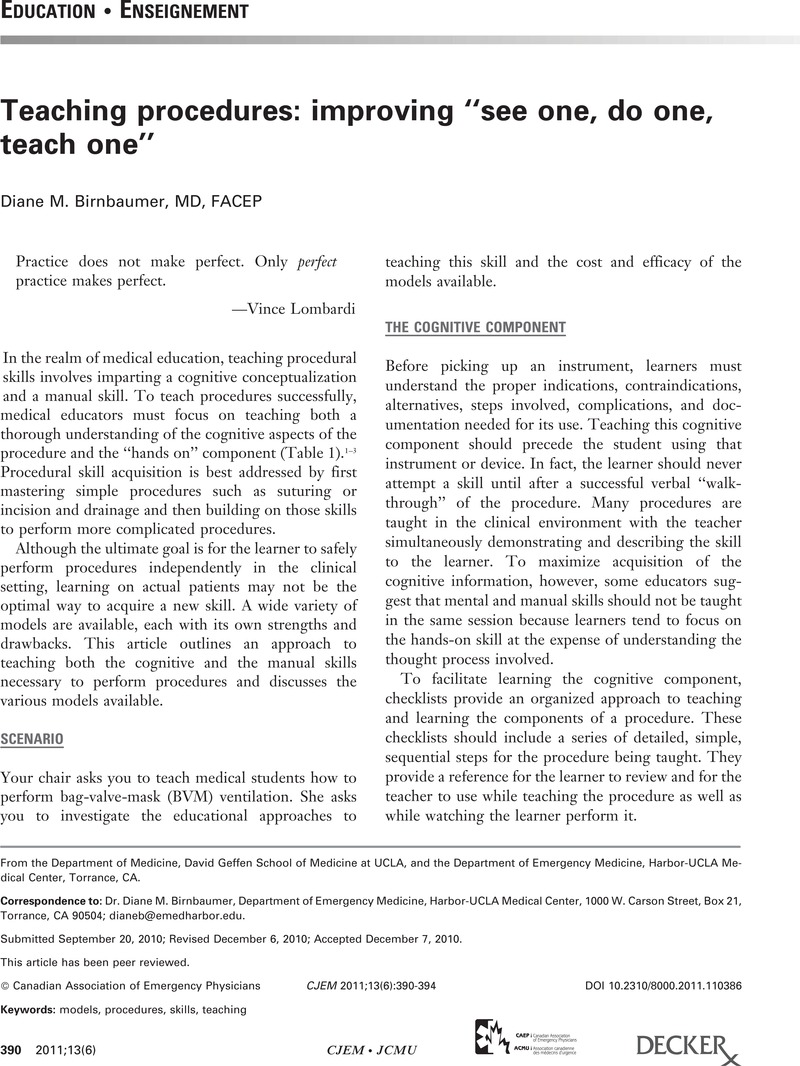Crossref Citations
This article has been cited by the following publications. This list is generated based on data provided by Crossref.
Katowa-Mukwato, Patricia
and
Banda, Sekelani S.
2014.
Medical Students’ Knowledge of Clinical Practical Procedures: Relationship with Clinical Competence.
Creative Education,
Vol. 05,
Issue. 21,
p.
1895.
Zoric, Lana
and
Savoldelli, Georges L.
2015.
Evidence base in airway management training.
Trends in Anaesthesia and Critical Care,
Vol. 5,
Issue. 1,
p.
36.
Charalambous, Charalambos Panayiotou
2015.
Career Skills for Doctors.
p.
87.
Oliver, Scott W.
Patel, Rajan K.
Ali, Khalid A.
Geddes, Colin C.
and
MacKinnon, Bruce
2015.
Teaching percutaneous renal biopsy using unfixed human cadavers.
BMC Nephrology,
Vol. 16,
Issue. 1,
Sánchez-Fernández, J.
Bachiller-Burgos, J.
Serrano-Pascual, Á.
Cózar-Olmo, J.M.
Martín-Portugués, I. Díaz-Güemes
Pérez-Duarte, F.J.
Hernández-Hurtado, L.
Álvarez-Ossorio, J.L.
and
Sánchez-Margallo, F.M.
2016.
The assessment of surgical skills as a complement to the training method. Revision.
Actas Urológicas Españolas (English Edition),
Vol. 40,
Issue. 1,
p.
55.
Sánchez-Fernández, J.
Bachiller-Burgos, J.
Serrano-Pascual, Á.
Cózar-Olmo, J.M.
Díaz-Güemes Martín-Portugués, I.
Pérez-Duarte, F.J.
Hernández-Hurtado, L.
Álvarez-Ossorio, J.L.
and
Sánchez-Margallo, F.M.
2016.
La evaluación de competencias quirúrgicas como complemento al método formativo. Revisión.
Actas Urológicas Españolas,
Vol. 40,
Issue. 1,
p.
55.
Garcia-Rodriguez, Juan Antonio
2016.
Filling the gaps between theory and daily clinical procedural skills training in family medicine.
Education for Primary Care,
Vol. 27,
Issue. 3,
p.
172.
Hughes, Patrick G.
Crespo, Maria
Maier, Tina
Whitman, Alia
and
Ahmed, Rami
2016.
Ten Tips for Maximizing the Effectiveness of Emergency Medicine Procedure Laboratories.
Journal of Osteopathic Medicine,
Vol. 116,
Issue. 6,
p.
384.
Charco-Mora, P.
Urtubia, R.
and
Reviriego-Agudo, L.
2018.
The Vortex model: A different approach to the difficult airway.
Revista Española de Anestesiología y Reanimación (English Edition),
Vol. 65,
Issue. 7,
p.
385.
Charco-Mora, P.
Urtubia, R.
and
Reviriego-Agudo, L.
2018.
El modelo del Vórtex: una aproximación diferente a una vía aérea difícil.
Revista Española de Anestesiología y Reanimación,
Vol. 65,
Issue. 7,
p.
385.
Brzezinski, Marek
Kukreja, Jasleen
and
Mitchell, John D.
2019.
Time-efficient, goal-directed, and evidence-based teaching in the ICU.
Current Opinion in Anaesthesiology,
Vol. 32,
Issue. 2,
p.
136.
Cassara, Michael
Schertzer, Kimberly
Falk, Michael J.
Wong, Ambrose H.
Hock, Sara M.
Bentley, Suzanne
Paetow, Glenn
Conlon, Lauren W.
Hughes, Patrick G.
McKenna, Ryan T.
Hrdy, Michael
Lei, Charles
Kulkarni, Miriam
Smith, Colleen M.
Young, Amanda
Romo, Ernesto
Smith, Michael D.
Hernandez, Jessica
Strother, Christopher G.
Frallicciardi, Alise
Nadir, Nur‐Ain
and
Runde, Daniel P
2020.
Applying Educational Theory and Best Practices to Solve Common Challenges of Simulation‐based Procedural Training in Emergency Medicine.
AEM Education and Training,
Vol. 4,
Issue. S1,
Cabar, Fábio Roberto
Lacerda, Daniele Costa Rachid
de Freitas, Gabriela Thomé Souza
and
Gorga, Maria Luiza
2020.
The need to standardize use of the newly deceased in medical trainings.
Clinics,
Vol. 75,
Issue. ,
p.
e2391.
DeVries, Gabriela
Rudolph, Megan
Reines, Howard David
and
Zapanta, Philip E.
2021.
A Qualitative Study of Developing Competency in Thyroid Surgery: A Resident’s Perspective With 5 Year Follow Up.
Annals of Otology, Rhinology & Laryngology,
Vol. 130,
Issue. 10,
p.
1132.
Collis, Sophia
Yung, Madeline
and
Parikh, Neeti
2023.
Evaluation of an Instructional Video and Simulation Model for Teaching Slit Lamp Examination to Medical Students.
Journal of Academic Ophthalmology,
Vol. 15,
Issue. 02,
p.
e215.
Peaslee Levine, Martha
and
M. Levine, Dayna
2024.
Trust and Psychology - Who, When, Why and How We Trust.



